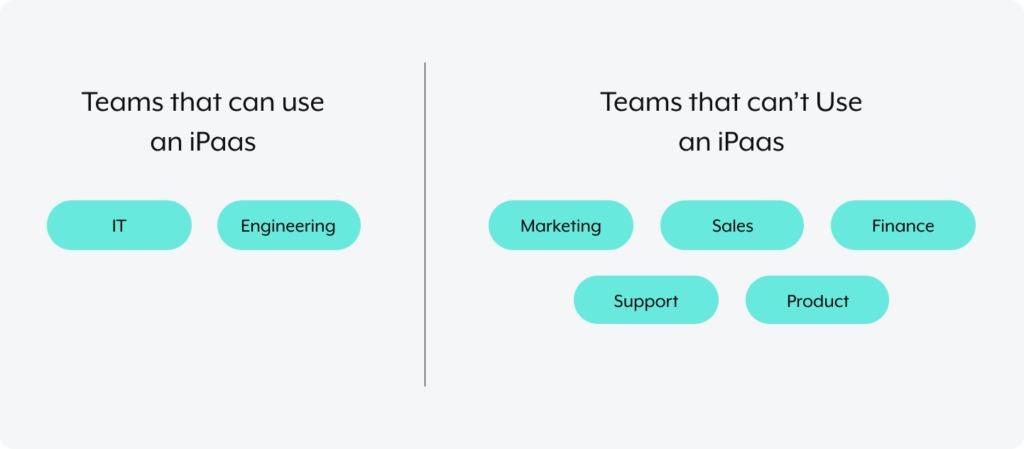As organizations search for a platform that can connect their SaaS apps and on-prem systems, they often end up picking an integration platform as a service (iPaaS).
The choice is a popular one for a number of reasons.
An iPaaS offers subscription-based pricing; it can connect a broad spectrum of apps and systems together, effectively eliminating data silos across your organization; and it allows your team to avoid building an integration solution in-house, which would be expensive and complex to set up and manage.
To really understand whether you should invest in an iPaaS, we’ll explore the aforementioned benefits further, review additional ones, and examine the platform’s drawbacks.
But to start, let’s align on what an iPaaS is.

Ready to leverage a best-in-class iPaaS solution?
Workato, the leader in enterprise automation, offers all of the benefits that you can expect from an iPaaS—and more.
What is an iPaaS?
An iPaaS is a cloud-based platform that allows you to connect your applications and on-prem systems, typically by their APIs. Once integrated, you can build data flows that work across these applications.
Broadly speaking, an iPaaS either moves data from one application to another or it keeps data that lives in multiple systems in sync. And since it generally relies on APIs, it can perform these actions dependably and in near real-time.
Top iPaaS benefits
Here are the top reasons to invest in an iPaaS:
1. It meets various data security and governance standards
Many iPaaS vendors meet a variety of important and highly-regarded data security and privacy requirements, such as SOC 2, HIPPA, and GDPR. This can ease your legal team’s concerns as you look to invest in an iPaaS, and it can meet your customers’ and prospects’ high expectations.
You’ll also find that various iPaaS solutions provide access controls across users. Generally speaking, this means that you can have an administrator who decides which employees to provision as users and what access levels to give each user (e.g. allowing users to only view and control certain integrations). Though this isn’t bulletproof in safeguarding your data, it should play a role in preventing security issues down the line.
2. It offers customer-centric terms of engagement
Since an iPaaS is offered as a subscription, your organization knows exactly how much you’ll pay over time. This, in turn, allows you to more easily forecast spending and manage your budget.
In addition, since the subscription can be just months-long, the iPaaS provider may be incentivized to continuously work hard in providing value for you and your team.
Related: Where an iPaaS and other methods for building integrations fall short
3. It provides a positive integration-building experience
The process of building integrations in-house can be extremely time consuming and resource intensive.
It requires involvement from your dev team, which prevents them from focusing on other business-critical projects. And since they’ll need to maintain and enhance the integrations over time, they’ll be called upon consistently.
An iPaaS gives your dev team an easier way to build and maintain integrations, as they can use the platform’s pre-built connectors, and implement and troubleshoot any integration through a centralized location.
4. It allows you to keep invaluable technology
Your organization might still rely on legacy, on-prem systems for managing day-to-day processes.
The prospect of replacing any, though seeming reasonable, isn’t always ideal. Why? Because the legacy system can be uniquely valuable to your organization, and replacing it would involve training employees on using the new system—taking valuable time away from your team.
An iPaaS can neatly address this challenge, as it allows you to integrate your legacy, on-prem technology with your technology in the cloud. This not only allows you to hold onto your legacy systems, but also access and leverage their data in new ways via your SaaS apps.
Related: A look at the pros and cons of using an iPaaS
5. It enables collaboration and time savings
With data readily available across systems and apps, employees in different departments can easily find and work off of the same set of information. This can help teams stay in sync and work together to drive value for the business.
For example, once you’ve integrated Salesforce and Marketo, your marketers and sales reps can see the same lead score, recent activities, etc. for each lead. This helps both teams align on the best time and way to engage a given prospect.
In addition, by eliminating data silos, employees no longer have to hop between apps to find data or manually re-enter it across their systems. This, in and of itself, could save your team a significant amount of time.
Popular Salesforce integrations
6. It drives employee satisfaction and retention
By allowing employees to avoid app-hopping, data entry, and building integrations in house, they can focus more of their time on business-critical, thoughtful work, instead. This should lead them to be happier at their jobs and more likely to stay put.
The data only validates this. According to a study by Deloitte, “Lack of challenge in the job” is one of the top 5 reasons why an employee would look for another job. Moreover, 42% of employees who are looking to switch jobs believe that their employer isn’t making effective use of their skills and talents.
Related: The top benefits of integrating your apps
7. It can offer API management capabilities
With API management available, your iPaaS solution can provide a host of additional functionality. You’ll be able to manage the full lifecycle of your APIs; you’ll be able to track each one’s level of adoption; and you’ll even be able to promote your APIs via a developer portal—where developers can discover them, learn how they work, and better understand how to build to them.
8. It could improve the quality of your product
Assuming you’re also investing in an embedded iPaaS—where you’re adding the iPaaS directly into your product—, your platform is set to provide significantly more value to clients as well as be more competitive in the market. Reason being, you’ll be able to take a significantly greater volume of product integrations to market faster; and your engineers can focus less on building and maintaining the integrations and more on executing key initiatives in your product roadmap.
Over time, this should translate to a variety of business benefits, from an improved customer retention rate to a higher average deal size to an increased volume of customer referrals.
9. It leads to better experiences for clients and prospects
By providing customer-facing employees with all of the data they need, when they need it, and where they need it, they’re able to make decisions and take actions that ultimately benefit clients and prospects.
This can take a number of forms: Customer support reps can discover support cases within the tool they rely on (e.g. ITSM platform), allowing them to resolve issues sooner; marketers can more easily pinpoint the campaigns that’ll resonate with and provide value to specific leads; and sales reps can uncover inbound leads in near real-time, enabling them to get back to these prospects faster.
Drawbacks of a traditional iPaaS
Despite the benefits we’ve covered, there are reasons to be wary of adopting a traditional iPaaS.
It isn’t accessible to the team at large
The process of building integrations with an iPaaS typically requires a certain level of technical expertise that prevents most teams from being involved.
This is an issue for several reasons:
- It leads to integration backlogs that frustrate employees and leave them without the data they need to perform their work.
Our own research confirms that this is already happening—82% of business technology professionals are backlogged with their integrations.
- It forces employees to be overly dependent on BT, which can lead to a fracture in the relationship between BT and lines of business when integrations aren’t delivered fast enough.
Our same study also found this to be true: 62% of BT professionals cite the inability to deliver integrations fast enough as a frustration, and BT professionals believe that it’s causing trust to erode between them and various lines of business. For instance, only 41% of BT professionals believe that their colleagues in the product team trust them.
It can’t deliver real digital transformation
Integrating your apps and moving data between them can only go so far in helping your business. To really change the way your organization operates, and to meet the growing demands of your customers and employees, you’ll need to integrate your apps AND automate your core workflows end-to-end.
Related: The shortcomings of application integration
How Workato meets the needs of today’s enterprise
Workato, the leader in enterprise automation, captures the benefits of an iPaaS while also addressing its drawbacks.
It allows you to integrate your apps, legacy systems, databases, etc. and automate your workflows without writing a single line of code. This enables the team at large to build enterprise-grade integrations and automations, and do so securely—as the platform provides a comprehensive, centralized governance model.
To give you an idea of how the platform can work, let’s review a common use case that we ourselves use—automating application provisioning for new hires.
1. Once the relevant stakeholders receive a “New Hire Notice”, or an email that’s sent from your HRIS and that contains key details on an incoming hire, the workflow gets triggered.
2. The hiring manager receives a notification from HRBot* in Slack; it prompts them to select the applications (along with the access levels) they’d like to provision for their incoming team member.
*HRBot is a customized Workbot. You can leverage Workbot for just about any process, and it’s compatible with the most popular business communications platforms, including Slack, Microsoft Teams, and Workplace from Meta.
3. Once the selections get submitted, HRBot messages IT in a specific Slack channel. Someone in the channel can then review the requests, approve (or reject) them, and schedule the applications to be provisioned by the beginning of the new hire’s first day—all in a matter of clicks.

